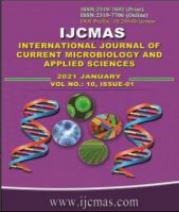


 National Academy of Agricultural Sciences (NAAS)
National Academy of Agricultural Sciences (NAAS)

|
PRINT ISSN : 2319-7692
Online ISSN : 2319-7706 Issues : 12 per year Publisher : Excellent Publishers Email : editorijcmas@gmail.com / submit@ijcmas.com Editor-in-chief: Dr.M.Prakash Index Copernicus ICV 2018: 95.39 NAAS RATING 2020: 5.38 |
Investigations on growth, morphology, biomass production of ten commercially important bamboo species was undertaken under rainfed conditions on agricultural wastelands. The study showed that at the end of 6th year maximum total biomass (ton/ha) was produced by Bamboosa bambose (261.89) followed by Bamboosa balcoa (224.40) followed by Dendrocal musstocksii (171.38) followed Bamboosa tulda (161.96). The lowest biomass production was estimated in Bamboosa multiplex (70.62) .Growth characters culm height, emergence of new culms, total number of culms showed significant variation with respect to different bamboo species. A first harvesting (50% removal of culms) was carried out at 6th year. In this first harvesting the maximum biomass yield (ton/ha) was recorded by Bamboosa bambose (42.37) followed by Bamboo sabalcoa (41.80) followed by Dendrocal musstocksii (35.09) followed Bamboo satulda (28.61). The lowest biomass yield was estimated in Bamboosa multiplex (11.77). The Cost of cultivation and monetary returns were worked out. A more than two benefit-cost ratio was worked out for Bamboosa balcoa (2.44) followed by Dendrocal musstocksii (2.39) and Bamboosa bambose (2.25) .Suggested these three species for commercial plantation in this region.
 |
 |
 |
 |
 |